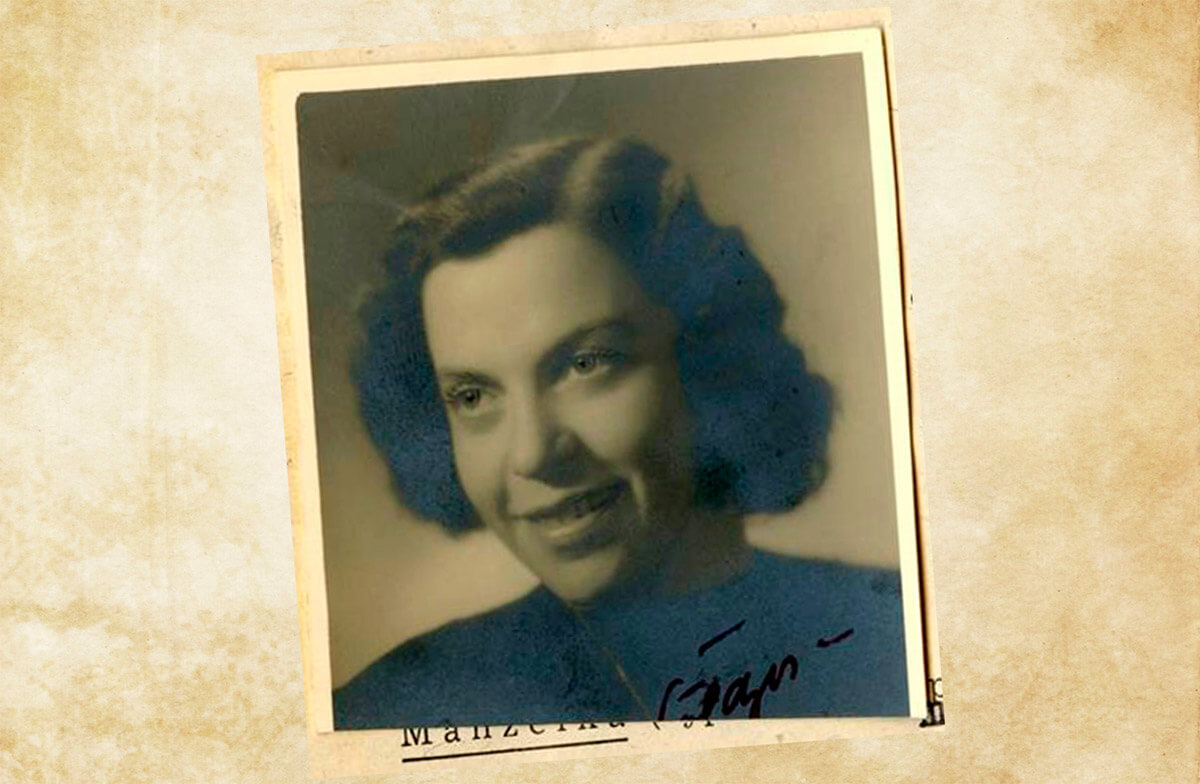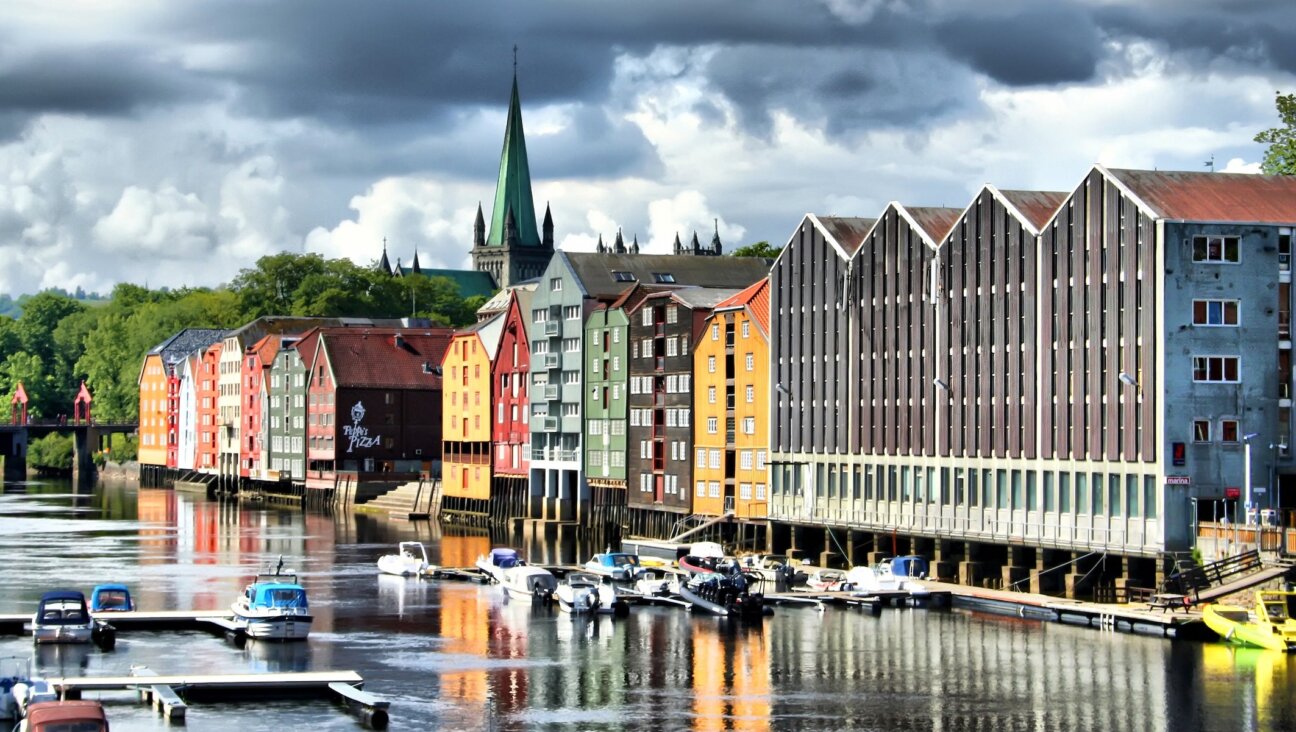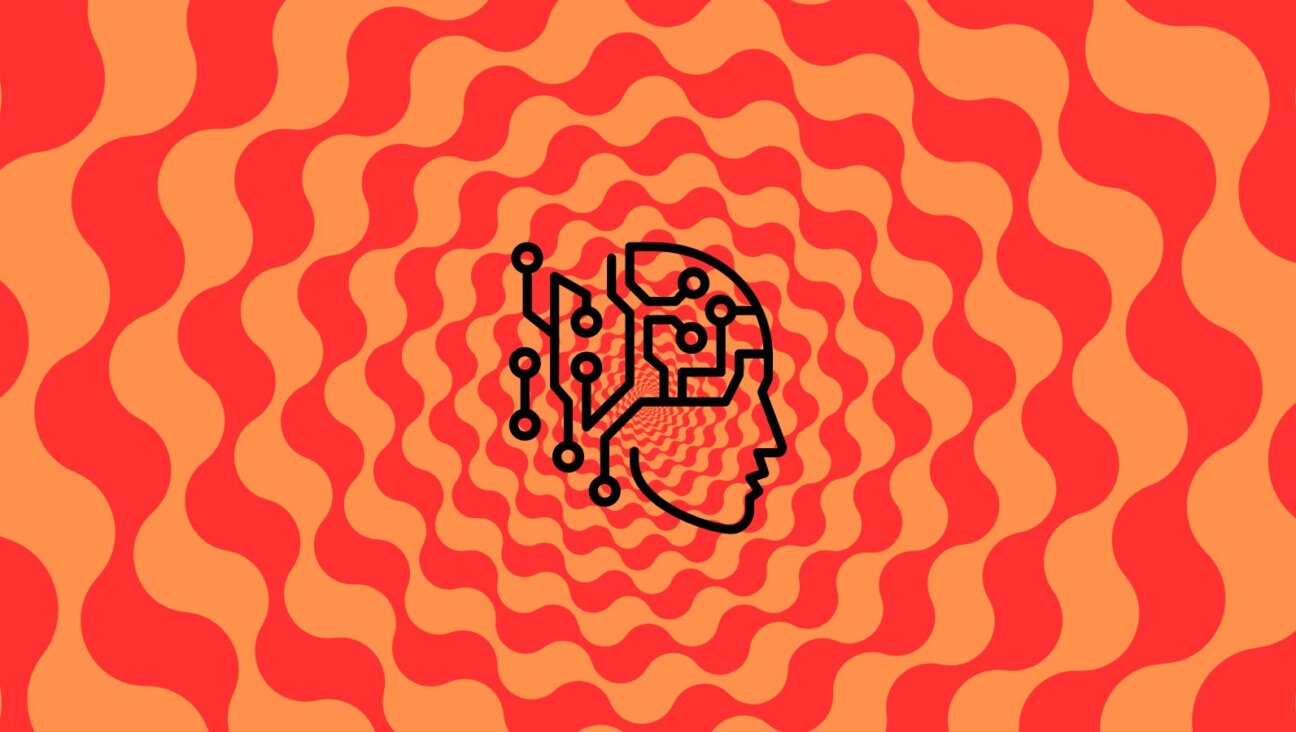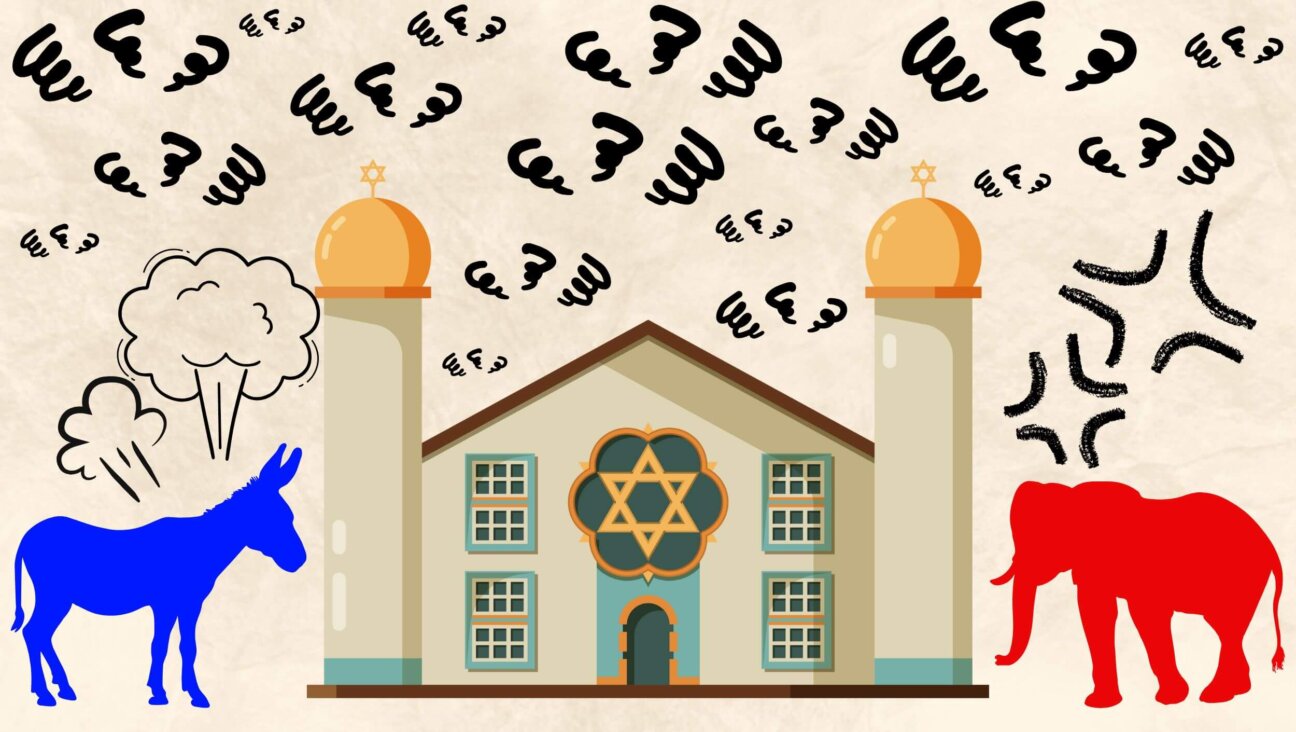She was in Auschwitz, but ‘had no idea she is in the Holocaust’
Prof. Hanna Yablonka, who pioneered the translation of Julia Skodova’s memoir into Hebrew, describes this unique report by a woman who was there from the first moments of the Final Solution.

The only surviving photo of Julia Skodova. Courtesy of Yedioth Publishers
This article originally appeared on Haaretz, and was reprinted here with permission. Sign up here to get Haaretz’s free Daily Brief newsletter delivered to your inbox.
It’s impossible to read the first sentences of Julia Skodova’s memoir with anything but mounting anxiety. She describes a stark reality, but given everything we know about what is about to happen to her and her companions, she seems almost naïve. Through her innocent eyes the horror unravels in real time.
Skodova’s memoir, “Three Years Without a Name,” recounts her life from the moment she boarded the train to Auschwitz. It documents her transfer to Birkenau, her survival, her participation in a death march, and finally, her return to her homeland. It’s a fascinating historical document, and much more.
“March 1942. At home, signs of spring have already appeared, but today I’m looking through the bars of a cattle car at snowy fields,” she writes. “The lack of air chokes me. For an entire day, we’ve been here, crammed next to each other. There are so many of us that we can’t sit down. Our only wish is to finally arrive at some destination. No place could be worse than here, in this car, where it’s impossible even to breathe.”
Over the years, historians have found several ways of learning about daily life in the camps. Preserved documents contain information about the system, the dates of events, orders that were given and their scope. Survivors have written about their experiences and what happened to them.
But there is almost nothing like Skodova’s testimony and her unique perspective. It’s no coincidence that she sounds almost naïve. Skodova, who was born Julia (Yuci) Foldi, was 28 years old when she boarded the first transport of Jews to Auschwitz. There were 999 women crammed into the suffocating cars, all young, unmarried women from Slovakia aged 15 to 31.
The instructions they received shortly before boarding said they were being taken to a labor camp. They were given a list of equipment to bring along: A hat, clothes, towels, blankets, silverware and dishes. It almost sounded like an adventure.
“This is someone who was there, from the moment the industrialized Final Solution begins, and is telling us about it,” says Prof. Hanna Yablonka, the Holocaust scholar behind the memoir’s recent publication in Hebrew (Yedioth Books and Yad Vashem Publications; translated from Slovakian by Avri Fischer).
“She doesn’t know that she’s in the Final Solution,” Yablonka continues. “She has no idea that she’s in the Holocaust. She only knows that she’s in a camp called Oswiecim and she describes what she sees, how she interprets what she sees. The only connection she has to reality is what she sees with her own eyes.”
“We have never had this information from the perspective of an innocent victim who doesn’t know anything about the Holocaust. I read the book and told myself that I don’t know anything about Auschwitz. What did I know about Auschwitz? Gas chambers, selection, ramp, transport. Those words. I didn’t even fully understand the difference between Birkenau and Auschwitz.”
“And thanks to Skodova, I have been sitting, day in and day out, studying Auschwitz – cross-referencing German information with this memoir and wondering, when did these girls learn that this place essentially means death? When they arrived, when people shouted at them to get off the train, there was no selection, no tattoo, no aktion and no Birkenau.”
Read with dread
We’ll return to Yablonka and her unique connection to Skodova’s diary – which made the memoir’s publication in Hebrew and rescue from oblivion possible. But even if its publication hadn’t required so much effort, the document would still be exciting.
Yuci Foldi was born on August 22, 1914 in the beautiful town of Levoca, a UNESCO World Heritage site surrounded by the Tatra Mountains. Her father, a lawyer, had his office on the bottom floor of their house.
Julia, the eldest child, studied languages at the university in Prague. Her brother Gustav was also a lawyer; the youngest brother, Coloman, died while he was still in high school. Levoca was a flourishing, ethnically-mixed city with a tiny Jewish community of just 600 people, around 90 families.
Everything changed after the Nazis rose to power and the Czechoslovakian republic broke apart. Slovakia became an independent fascist state in 1939, a satellite under German protection. The rest of Czechoslovakia became a protectorate under German control.
The 90,000 Slovakian Jews were the first to experience the Judenrat system, which was put into effect across the country. In 1942, a few months after the Judenrat was established, Slovakia was ordered to dispatch the first transport to Auschwitz as part of the Final Solution. This is the transport Skodova boarded.
She wasn’t the only person from her town aboard. All the Jewish girls from Levoca within the specified age range, 27 in total, boarded the train and vanished. Only five survived. It’s difficult to imagine the terror and distress of those who stayed behind as their daughters disappeared, at a time when nobody yet knew about Auschwitz or the organized machinery of annihilation.
Terror and distress awaited the young women as well. As soon as they got off the train, Skodova writes, they were forced to strip. They were pushed into a small pool where their hair was shaved off and they were ordered to wear old Red Army uniforms and wooden clogs.
They were assigned numbers 1,000 through 1,998. Though it would be some time before those numbers were tattooed on their arms, they were no longer treated as human beings with names. Skodova’s number was 1,054.
A few days after her arrival, she describes an unusual incident: “One day, at around 10 A.M., we heard shooting and then a scream… That 18-year-old murderer wanted to see blood, and his heart’s desire could be granted here without any danger,” she wrote.
“The girl was as pale as whitewash. She was bleeding. Still alive. We stood at a distance from her. We were forbidden to go near her, forbidden to help our mortally wounded friend. We were forbidden to comfort her, forbidden to hear her last words. Her pale lips trembled as if they were speaking her final word – ‘mother’… Later, we saw corpses piled up like logs of wood, and we didn’t panic over hearing shots.”
Skodova wrote her memoir after she was liberated, but at a time when her memories were still fresh. She describes working in the fields, and then receiving a better job under a roof – which enabled her to survive the later years. She describes the routine of terrible hunger and thirst, which led many prisoners to drink filthy water.
More and more transports came to Auschwitz from across Europe. She writes about the high suicide rate among Dutch women, the relationships that supported the girls from her city and finally, the transfer to Birkenau – a terrible place, even for someone who had spent years in Auschwitz.
She describes how the mood in the camps and among the SS shifted as the war continued and Germany began to lose. She writes about the death march from Poland to Germany, which she endured while burning up with fever, sick with typhus and severe pneumonia. It is a document that is read with genuine dread.
Despair is evident in every sentence. Her legs are heavy as lead, and her thoughts are filled with a longing for death – to fall asleep in the snow and never wake up. It’s a torture that lasts for months. She survives, with great difficulty, only thanks to a good friend.
Skodova sticks to description; her thoughts don’t wander into philosophy or literary flights of fancy. For that very reason, it is hard to put the book down.
“We heard one shot, and then a second and third. Do you know what it means?” she wrote. “During the march, I see bodies thrown on both sides of the road like avenues of chopped-down trees. This avenue of bodies gets more and more crowded. I see faces, but I don’t know who lies there. I must go by the body and keep marching. Another girl musters up her courage and stops walking. Really, why shouldn’t I do what she did?”
Before the death march, which ended with the Russian occupation, Skodova and her friend went from one concentration camp to another, and then to a hospital where she is treated for a short while. After she is liberated, she begins a month-long journey back to Slovakia.
Even her return home is harrowing. After surviving for so long, a genuine miracle, she discovers that her entire family is dead, except for her brother Gustav.
In an effort to rebuild their lives, the two move to the Slovakian capital, Bratislava. Julia is hospitalized for an entire year. After recovering, she meets Julius Skoda and marries him. She teaches French and German at the university and works at writing down her experiences, which were ultimately published under the title “Three Years Without a Name.” A single edition came out, and then the book disappeared.
Nine years later, on April 23, 1971, Skodova committed suicide. She stipulated that her body be cremated and left nothing behind – no explanation, no grave and no offspring.
The archaeology of Auschwitz
Skodova’s rare testimony might have been entirely forgotten, had it not been for an unusual combination of circumstances. In 1962, the year her book was published, she made her first and only trip to Israel. Skodova was 48 at the time. Her visit had two aims – to reunite with people she had known in her youth and to give them a copy of her book.
The two people she visited were her father’s brother, Martin Foldi (whose testimony during the Eichmann trial about his young daughter wearing a red coat was later incorporated into the film “Schindler’s List”), and Viola Klein, now Viola Torek, who was her neighbor in Levoca. Torek’s sister, Lily Klein, was aboard the same transport as Skodova and only survived for a few months in Auschwitz.
Nine years later, Skodova committed suicide. Her uncle took his own life as well. He had no children and his copy of the book disappeared. Viola Torek’s copy was dear to her, the last remnant of Skodova’s life, and she guarded it zealously.
Torek – that is, Dr. Torek, who is now 106 years old – not only lived three houses down from Skodova’s childhood home, she is also the doctor who founded the public health service in Israel’s south. Further, she is Hanna Yablonka’s mother.
Yablonka, a well-known Holocaust researcher, has explored every aspect of the lives of survivors and their offspring in her work. Her most recent book, “Children by the Book,” which became a best-seller, is about second-generation survivors. She was ideally situated to get a Hebrew version of Skodova’s book published.
“Out of 90,000 Jews in Slovakia, 70,000 were murdered,” she said. “This Jewry didn’t survive. Those who did survive and came to Israel knew each other and remained in contact.”
“Martin Foldi was a friend of my parents, and I knew from my mother that Skodova had been a neighbor,” she added. “I was familiar with the story of the girls who disappeared, and they remained in regular contact, despite the Iron Curtain, until she killed herself.”
What did you know about the book?
“For my mother, it was the most valuable thing in the house. But I couldn’t read Slovak, so I never read it – except for the parts my mother would translate and read to me from time to time. I knew what was in the book, but the years passed. Twenty years ago, I went to Yad Vashem and asked if they would push the book to the front of the line and get it published. I thought we needed to rescue it because it provides testimony that can’t be found anywhere else – from the first transport, the first moments of Auschwitz’s existence to the end of the death marches. It is a witness to it all.”
Yad Vashem delayed, and the years passed quickly. About a decade ago, a team came to Dr. Torek’s home to copy the book for translation, because she refused to give them the rare copy in her possession, but the delays continued.
Yablonka immersed herself in her academic career and writing, but then “I just got this idea in my head. I suddenly remembered how old my mother was and how much I wanted her to live to see the Hebrew translation published, and that I wanted to be able to read it myself.”
At the end of 2019, Yablonka approached Dov Eichenwald, the publisher at Yedioth Books, who responded immediately. The book project finally moved forward with joint funding from two bodies. Yablonka provided the scholarly context (explanatory notes, additional information and cross references that appears throughout the text) and an introduction. During the first COVID-19 lockdown in 2020, the long-awaited translation arrived by email. Yablonka described her excitement: “I saw the translation in my email and a tear spilled from my eye. I immersed myself in reading it and experienced an emotional upheaval that I can’t describe.”
Was that because of your role as a historian looking at testimony of immense importance, or because of your emotional and familial connection to the story?
“I realized what this book was, both in my personal history and as a historian. It contains the archeology of Auschwitz as it has never been told. We know about Auschwitz mainly from German documents and from people who recorded their memories of what they knew. They came at the end of ‘42 or the middle of ‘43; the Hungarians came in the middle of ‘44. They wrote only a fraction [of what was]. Here, we have everything. The book starts in the spring when they arrived at the camp. Years ago, I wrote a book about the Eichman trial, and would sit in front of the computer and look at the testimony. On the second or third transport, one of the witnesses, Vera Alexander, arrived. It was about two weeks after these women arrived. What Skodova describes you also find in Alexander’s testimony, which describes women who seem to be crazy, signaling to them with odd motions. On Alexander’s transport, they argued about whether these strange people were male or female – they had been shaved and were so emaciated. But after the women in the Alexander’s transport go through the selection, they understand what the women had been trying to tell them – ‘We have ceased to be women.’”
And through Skodova’s eyes, we can also understand something about the inertia of the Final Solution.
“She describes how at a certain point, toward June, families start to arrive, and the girls are happy because they haven’t seen children in a long time. After one of these transports, the following day, they see the mothers and children walking. They’re well-dressed and with suitcases, happily saying that they are leaving. The next day, one of the laundry workers says that she washed clothes that look just like those worn by the mothers who had left. The women ask her to bring them the clothes, and then someone else says, ‘You don’t want to wear those clothes.’ Here as well, you see this process of gradual understanding that these mothers didn’t leave the camp on foot, but skyward.”
Through their eyes, you understand that what is going on is so monstrous that even everything they have been through – hunger, cold, sickness, violence, disease and deprivation – they still can’t comprehend it.
“Exactly. They can’t imagine it. From the moment a person is born and becomes a sentient being, he lives in denial of his finiteness. Everyone denies death and the transience of everything. But these are young girls whose denial is unconscious. But there is a moment when they are forced to register that this place has a meaning, and it’s not what they thought. What they see on a day-to-day basis, what they interpret and how they behave is archaeology. We have no other book that has survived and provides similar testimony.”
Two additional obstacles remained. The first was discovering the date of Skodova’s death. The second was the hunt for a photo of her. In both cases, the mission seemed impossible. Slovakian law states that information about a person’s life or death may only be divulged to that person’s direct descendents. Given that Skodova had no remaining family, Yablonka relied on the cooperation of Skodova’s relatives in Israel and in Slovakia and the Slovakian Holocaust Documentation Center, as well as a good deal of cunning and initiative.
Her date of death was found after an urn with her ashes was thrown out of the local crematorium, because no one paid for it to be kept there. A careless clerk let the information slip and quickly ended the conversation, saying, “I can not divulge any further information.” It was more difficult to get hold of Skodova’s photo. Nothing had survived in any of the archives and nobody had one. Salvation came from the Slovak Holocaust Documentation Center, which realized that since Skodova had a passport, a copy of her photo may exist somewhere. An official letter from the State of Israel, signed by the then-Minister of Education Yoav Galant and the Chairman of Yad Vashem opened the door, and they were finally able to get a copy of the priceless photo that appears on the cover of the book and here in this article.
“After the war, Skodova returned home. She returned at the end of May 1945. She was very sick, literally on her death bed and in the hospital. She went to Levoca and there she argued with my mother’s sister – who had survived – about whether surviving had been worthwhile. Via the Documentation Center, I have a letter that she wrote to my mother back then. Through the Documentation Center we reached a friend of Skodova’s, a 98-year-old lady, who told us that Skodova had hoped that after writing the book she would find some relief, but she never managed to. She is not the only one who wrote in the early wave of testimonies and then committed suicide. There were others.”
How do you explain that people who had survived so much and understood the importance of their fresh memories committed suicide?
“I think it was a psychological crisis, the collapse of everything they believed in – the goodness of man, family, community. That was the great loss. My mother always said that she didn’t know what was better, that she survived or that her parents and sisters died there. We will never know what she went through. Skodova’s friend, whom we found, told us that she was miserable and that she had a bad marriage, but we can only remember her as she appears in the book and as she is in the photo that we have. Beautiful and smiling.”
This article originally appeared on Haaretz, and was reprinted here with permission. Sign up here to get Haaretz’s free Daily Brief newsletter delivered to your inbox.






















